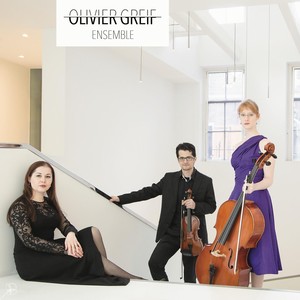专辑简介
As a trio Jesús, Victoria and I made first contact through Olivier Greif’s music. While we had previously performed repertoire for violin-piano and cello-piano we discovered one another in Greif’s rather unique and intense language. Nevertheless, for our first recording we chose to highlight a part of the works which accompanied our beginning on stage rather than to present a very specific theme. Thus the works of Fauré, Bloch, Debussy and Turina present an overview of our artistic, stylistic and musical affinities.Gabriel Fauré’s Piano Trio, considered by many to be a perfect achievement of its kind in 20th century music (with Ravel’s Trio), appears to be of an infinite modesty. Refined to the essence of the subject but nevertheless beautifully balanced, we strive to underline the elegance and fluidity of the large unisono string lines as well as the rhythmical and harmonic richness of the piano writing.Bloch’s Three Nocturnes for piano trio, while devoid of any specific programmatic significance, can be perceived as a tightly knitted triptych. This work being rather far from Bloch’s first compositional period—using Jewish melodic material with expansive and striking gestures—is characterized by subtlety, restraint and well-balanced unity. The first Nocturne evolves in quite an impressionistic atmosphere using diverse kind of ethereal colors and textures. The second one develops a tender and lyrical theme in canon as a lullaby, softly falling towards sleep. The last movement, with its tempestoso character, is far more wild and restless, depicting a tormented and agitated night which fades away spectrally.The arrangement of Debussy’s opera, Pélléas et Mélisande by Hubert Mouton, belongs to an eclectic collection of small treasures–unfortunately not often played–that we hold dearly. This piece is part of a big collection of opera arrangements and other orchestral works set for small ensembles, initiated by Ernest Alder at the end of the 19th century in order to promote them by making them more accessible to a larger audience. The core of the piece is a succession of Debussy’s opera highlights selected by Mouton—and fully focused on Pélléas and Mélisande story since it ends right on Pélléas’s death–creating a brand new ”condensed” work in a free form succeeding in preserving all orchestra colors and textures for piano trio.Turina’s second Trio was composed in 1933 and has the specificity to have been premiered in Groningen (The Netherlands) the same year. This work can be seen as a very colourful patchwork of various impressions in a rather free form with a wide variety of tempi. ”Originally conceived, it seems, as a set of three Nocturnes, its outstanding first movement, whose broad initial phrase, of romantic brahmsian resonances, makes one forget for a moment that we are standing before a music of a nationalistic nature. The nationalism doesn’t take long to appear, in a crafted synthesis between both aesthetics” as José Luis Turina, Turina’s grandson remarked. The second movement brings a sparkling contrast with its 5/8 meter and its typically Spanish spirit while the third movement brilliantly ends the work with its mood changes and its development in Fauré’s manner, Turina’s French training being always present.This ”musical medley“ mirrors our own artistic interests, filled with contrasting atmospheres, textures, colors, characters, styles and more as a way to share our own enthusiasm, happiness and intensity with our audience when performing them live.Anne-Elise Thouvenin

